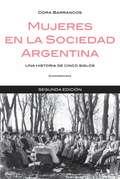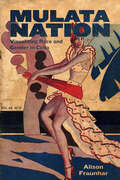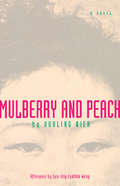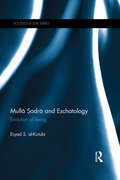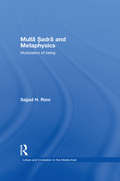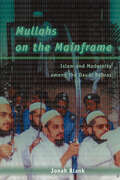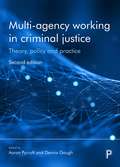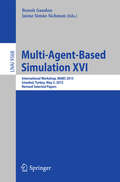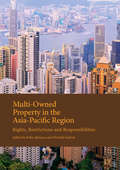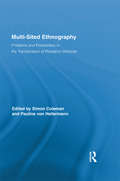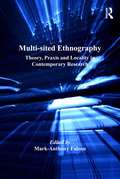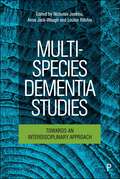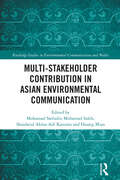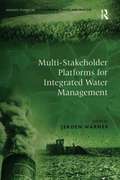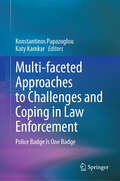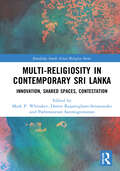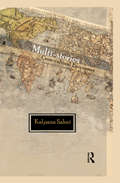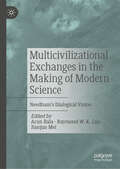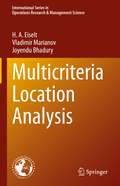- Table View
- List View
Mujeres en la sociedad Argentina: Una historia de cinco siglos
by Dora BarrancosUna historia de las mujeres argentinas desde la conquista hasta laactualidad, por una gran especialista en el género. La historia de las mujeres representa una de las vertientes másvigorosas de la historiografía actual. Su principal cometido es hacervisible la presencia femenina a lo largo de los tiempos, saldando así undébito de la empresa histórica. No se trata solamente de reconocer lascontribuciones de las mujeres o de celebrar sus méritos, sino sobre todode vislumbrarlas cualquiera sea la trascendencia de sus actos. Estelibro se ha basado en un enorme volumen de investigaciones sobre la vidade las mujeres desde el período precolombino y da cuenta de los cambiosde las relaciones de género -que deben comprenderse como relacionesentre mujeres y varones- en el transcurso de cinco siglos. No hay dudassobre la inferioridad que aquellas han padecido, reforzada en el sigloXIX cuando se ampliaron los derechos de los varones. Pero siempre huboformas de burlar la sujeción. El feminismo y los cambios notables delsiglo XX minaron preconceptos y pudo avanzarse en ciertos derechos. Delmandato exclusivo del «ángel del hogar», se evolucionó a laincorporación de las mujeres a la vida política y a otros dominiospúblicos. Sin duda, en las últimas décadas se alteraronsignificativamente las normas morales coercitivas. Y aunque lastransformaciones resultan incontestables, nuestra sociedad espera aúnpor la completa equidad entre los sexos.
Mujeres que corren con los Lobos
by Clarissa Pinkola Estés«En toda mujer hay fuerzas poderosas pendientes de descubrir.» Mujeres que corren con los lobos es un fascinante mosaico de historias que nos ofrece una nueva visión de lo femenino y de sus posibilidades. Dentro de toda mujer alienta una vida secreta, una fuerza ponderosa llena de Buenos instintos, creatividad y sabiduría. Es la Mujer Salvaje, una especie en peligro de extinción debido a los contantes esfuerzos de la sociedad por «civilizar» a las mujeres y constreñirlas a rígidos papeles que anulan su esencia instintiva. En este libro, Clarissa Pinkola Estés revela ricos mitos interculturales, cuentos de hadas e historias (muchas de ellas relativas a su propia familia) para contribuir a que las mujeres recuperen su fuerza y su salud, atributos visionarios de esta esencia instintiva. Mediante los relatos y los comentarios de la autora, examinamos el amor y comprendemos a la Mujer Salvaje. Estés ha creado una psicología femenina en un sentido más verdadero, el que lleva al conocimiento del alma.
Mulata Nation: Visualizing Race and Gender in Cuba (Caribbean Studies Series)
by Alison FraunharRepeatedly and powerfully throughout Cuban history, the mulata, a woman of mixed racial identity, features prominently in Cuban visual and performative culture. Tracing the figure, Alison Fraunhar looks at the representation and performance in both elite and popular culture. She also tracks how characteristics associated with these women have accrued across the Atlantic world.Widely understood to embody the bridge between European subject and African other, the mulata contains the sensuality attributed to Africans in a body more closely resembling the European ideal of beauty. This symbol bears far-reaching implications, with shifting, contradictory cultural meanings in Cuba. Fraunhar explores these complex paradigms, how, why, and for whom the image was useful, and how it was both subverted and asserted from the colonial period to the present. From the early seventeenth century through Cuban independence in 1899 up to the late revolutionary era, Fraunhar illustrates the ambiguous figure's role in nationhood, citizenship, and commercialism. She analyzes images including key examples of nineteenth-century graphic arts, avant-garde painting and magazine covers of the Republican era, cabaret and film performance, and contemporary iterations of gender.Fraunhar's study stands out for attending to the phenomenon of mulataje not only in elite production such as painting, but also in popular forms: popular theater, print culture, later films, and other media where stereotypes take hold. Indeed, in contemporary Cuba, mulataje remains a popular theme with Cubans as well as foreigners in drag shows, reflecting queerness in visual culture.
Mulatto America
by Stephan TaltyBlack and white culture has been blending and colliding in America for hundreds of years. In the 1700s, black slaves discovered their masters' Bibles and found in them a seditious faith of their own. In the 1920s, young white men fell in love with New Orleans jazz and created an underground of cultural dissidents. In the 1970s, black style began its takeover of the sports world and made Dr. J and Michael Jordan the idols of millions. In Mulatto America, a dazzling work of cultural history, the stories of these daring and deeply influential encounters are described in vibrant detail. Beginning with new and shocking revelations about the white slaves kidnapped into "the House of Bondage," Mulatto America vividly chronicles the hidden connections that have shaped American style and character. Stephan Talty proposes that, along with the hatred that ruled the relationship between blacks and whites for so long, there has been a largely unexamined flip side: a powerful attraction that led both races to mimic what they saw and desired in each other. The pages of this groundbreaking work, which introduces a strong new voice, are populated by the renegades who crossed the color line out of deep conviction or wild curiosity: W. E. B. Du Bois, Dorothy Dandridge, Elvis, Jay-Z, and many others. Each chapter examines a different vanguard: The interracial lovers of the slavery era who ignored theories of racial inferiority and gave us models of devotion and daring. The black elite early in the last century who found in Shakespeare and Michelangelo not only deeply humanist masterpieces but hope that white bigotry could be overcome. And the members of today's hip-hop generation, who revel in the cultural freedom earned at so high a cost. Drawing on original research and daring new interpretations of crucial events in American history, Talty paints a portrait of a lost America: one in which musicians, writers, and ordinary people led the nation to a deeper understanding of the strangers on the other side of town. Without the mixing of black and white culture, America would look, sound, and feel completely different than it does today. On a cultural level, as well as racially, we are indeed a mulatto nation. This provocative and highly engaging new history shows us how this came to pass.
Mulberry and Peach
by Sau-Ling Wong Hualing NiehThis extraordinary novel tells the story of two women-Mulberry and Peach-who are really one. Mulberry is a young Chinese-American woman who has fled the turmoil of postwar China to settle in the United States. Unable to forget the terrors she has witnessed or to resolve the conflicts between her new life and her old, she copes by developing a second personality: the fearless, tough-talking, sexually uninhibited Peach. While Mulberry clings to her cultural and ethical roots, Peach renounces her past to embrace the American way of life with a vengeance. These two women-both in flight-speak to their readers through an innovative narrative structure, combining journal entries, interior dialogue, letters, poetry, and myth. Mulberry's past-mainly her experiences during the Japanese occupation of China and the years of civil war between Communists and Nationalists-haunts the text. Separated from her family, she seeks refuge in the home of wealthy cousins, who try desperately to maintain their rigid traditions as warrign forces close in around Peking and the house is systematically looted. Mulberry escapes downriver in a boat carrying a strange assortiment of refugees. But her escape to Taiwan only brings new terrors: when her new husband is targeted by the police, Mulberry msut go into hiding with him in a tiny attic room. There her young daughterm who cannot remember life "outside", descends into a fantasy world of her own invention and unwittingly ensures her family's doom, Mulberry's journal entires alternate with a series of letters from Peach to "the man from the USA immigration service." Peach has embarked on a cross-country journey in flight from possible deportation. Pregnant and penniless, she lives by her wits while taunting her pursuers and ridiculing her alter ego Mulberry, whom she seeks, finally, to conquer. In Mulberry and Peach Hualing Nieh offers a rare perspective, through the eyes of a young refugee woman, of the upheavals of contemporary China (where the book was banned upon its first publication in 1976). Through her experimental, highly effective narrative, she also presents an unforgettable portrait of the pain of cultural dislocation and the anguish of psychological disintegration.
Mule Trader: Ray Lum's Tales of Horses, Mules, and Men (Banner Books)
by William R. FerrisReaders captivated by this book will be happy that Bill Ferris found Ray Lum and that he thought to turn on a tape recorder. Lum (1891-1977) was a mule skinner, a livestock trader, an auctioneer, and an American original. This delightful book, first published in 1992 as “You Live and Learn. Then You Die and Forget It All,” preserves Lum's colorful folk dialect and captures the essence of this one-of-a-kind figure who seems to have stepped full-blooded from the pages of Mark Twain. This riveting tale-spinner was tall, heavy-set, and full of body rhythm as he talked. In his special world, he was famous for trading, for tale-telling, and for common-sense lessons that had made him a savvy bargainer and a shrewd businessman. His home and his auction barn were in Vicksburg, Mississippi, where mules were his main interest, but in trading he fanned out over twenty states and even into Mexico. A west Texas newspaper reported his fame this way, “He is known all over cow country for his honest, fair dealing and gentlemanly attitude. . . . A letter addressed to him anywhere in Texas probably would be delivered.” Over several years, Ferris recorded Lum's many long conversations that detail livestock auctioneering, cheery memories of rustic Deep South culture, and a philosophy of life that is grounded in good horse sense. Even among the most spellbinding talkers, Lum is a standout both for what he has to say and for the way he says it. Ferris's lucky, protracted encounters with him turn out to be the best of good fortune for everybody.
Mulla Sadra and Eschatology: Evolution of Being (Routledge Sufi Series)
by Eiyad S. Al-KutubiThe book explains Sadrā’s theory of the nature of afterlife. It presents Sadrā’s philosophical premises concerning the nature of human beings and their physical and psychological developments through which Sadrā shows how the afterlife is intimately connected to the nature of the human being and how it is a natural stage of the evolution of each individual in which a corporeal body has no role. Presenting Mullā Sadrā in a new light, the aim of this book is to investigate Sadrā’s metaphysical principles of the Return (al-ma‘ād) that have been either partially presented or misunderstood in most of the existing secondary literature. Focusing on Sadrā’s philosophical works, specifically the Asfār and his commentary on the Quran, this study demonstrates how Sadrā is a philosopher able to carry the premises of the previous philosophical theories to radically different conclusions. Mullā Sadrā and Eschatology demonstrates the manner in which Sadrā explains the Return as presented in the Quran and Hadith, but also shows how he presents the Return as a natural stage of the evolution of human beings in which a corporeal body has no role. Thus, Sadrā offers a plausible philosophical explanation to the problem of bodily resurrection that had occupied Muslim philosophers for centuries. Explaining Mullā Sadrā ‘s distinctive method of "doing" philosophy, this book will be of interest to students and scholars of Islamic Philosophy, Religion and Islamic Studies more broadly.
Mulla Sadra and Metaphysics: Modulation of Being (Culture and Civilization in the Middle East)
by Sajjad H. RizviMulla Sadra is one of the most important Islamic philosophers after Avicenna. In this exploration of his philosophy, Sajjad H. Rizvi examines the central doctrine of the modulation of being, and contextualises his work within the intellectual history of philosophical traditions in the Islamic East. Reading and critiquing the works of Mulla Sadra from an analytical perspective, this book pays particular attention to his text the Asfar, a work which, due to its complexity, is often overlooked. Looking at the concept of philosophy as a way of life and a therapeutic practice, this book explores the paradigm of the modulation of being in the philosophical method and metaphysics of Mulla Sadra and considers its different manifestations. Rizvi relates his philosophy to larger trends and provides a review of the field, charting and critiquing the discussion on the topic to date and exploring recent thought in this direction, to show how Sadrian thought was addressed well into the 19th and 20th centuries. This major contribution to the study of Mulla Sadra and the intellectual life of the Safavid period fills an important gap in the field of Sadra studies and Islamic philosophy, and is indispensable to students of philosophy, religion and Islamic studies, and Islamic philosophy in particular.
Mullahs on the Mainframe: Islam and Modernity among the Daudi Bohras
by Jonah BlankIn Jonah Blank's important, myth-shattering book, the West gets its first look at the Daudi Bohras, a unique Muslim denomination who have found the core of their religious beliefs largely compatible with modern ideology. Combining orthodox Muslim prayer, dress, and practice with secular education, relative gender equality, and Internet use, this community serves as a surprising reminder that the central values of "modernity" are hardly limited to the West.
Mullahs on the Mainframe: Islam and Modernity among the Daudi Bohras
by Jonah BlankIn Jonah Blank's important, myth-shattering book, the West gets its first look at the Daudi Bohras, a unique Muslim denomination who have found the core of their religious beliefs largely compatible with modern ideology. Combining orthodox Muslim prayer, dress, and practice with secular education, relative gender equality, and Internet use, this community serves as a surprising reminder that the central values of "modernity" are hardly limited to the West.
Multi-Agency Working in Criminal Justice 2e: Theory, Policy and Practice
by Aaron Pycroft & Dennis GoughMulti-agency working continues to be a core focus in criminal justice and allied work, with the government investing significantly in training criminal justice professionals. This fully revised and expanded edition of this comprehensive text brings together probation, policing, prison, social work, criminological and organisational studies perspectives, and is an essential guide for students and practitioners in offender management and other managed care environments. The contributors provide critical analysis of the latest theory, policy and practice of multi-agency working and each chapter includes case studies, key points, exercises and further reading.
Multi-Agent Based Simulation XVI
by Benoit Gaudou Jaime Simão SichmanThis bookconstitutes the thoroughly refereed post-conference proceedings of the 16thInternational Workshop on Multi-Agent-Based Simulation, MABS 2015, held inIstanbul, Turkey, in May 2015. The workshop was held in conjunction with the14th International Conference on Autonomous Agents and Multi-agent Systems,AAMAS 2015. The 12revised full papers included in this volume ware carefully selected from 22submissions. The papers focus on theinfluence of social sciences and multi-agent systems, with a strongapplication/empirical vein, and its emphasis is stressed on exploratory agentbased simulation as a principled way of undertaking scientific research in thesocial sciences and using social theories as an inspiration to new frameworks and developments in multi-agent systems.
Multi-Method Social Science
by Jason SeawrightReflecting the rising popularity of research that combines qualitative and quantitative social science, Multi-Method Social Science provides the first systematic guide to designing multi-method research. It argues that methods can be productively combined using the framework of integrative multi-method research, with one method used to carry out a final causal inference, and methods from other traditions used to test the key assumptions involved in that causal inference. In making this argument, Jason Seawright considers a wide range of statistical tools including regression, matching, and natural experiments. The book also discusses qualitative tools including process tracing, the use of causal process observations, and comparative case study research. Along the way, the text develops over a dozen multi-method designs to test key assumptions about social science causation.
Multi-Owned Property in the Asia-Pacific Region: Rights, Restrictions And Responsibilities
by Erika Altmann Michelle GabrielThis book provides critical insight into the experience of multi-owned property, and showcases different cultural responses across the Asia-Pacific region. Escalating demand for properties within global cities has created exuberance around apartment living; however less well understood are the restrictions on individual rights and responsibilities associated with collective living. In contrast to the highly populated and traditional communal housing arrangements of past Asian economies, we see an increasing focus on neo-liberalist, market-based policies associated with the rise of an Asian middle class shaping structural change from communal to individualistic. This edited collection unpacks the rights, restrictions and responsibilities of multi-owned property ownership across the Asia-Pacific region; examining the experiences of developers, strata-managers, owners and residents. In doing so, they highlight how the rights of one party affects the restrictions and responsibilities of others within different policy frameworks. This work will reach an interdisciplinary audience including scholars and practitioners of sociology, public policy, urban studies and planning, economics, property management and architecture.
Multi-Sited Ethnography: Problems and Possibilities in the Translocation of Research Methods (Routledge Advances in Research Methods)
by Simon Coleman Pauline Von HellermannThis collection of essays emerged out of intense conversations on multi-sited ethnography, prompted by a workshop held at the University of Sussex that brought together researchers from different institutional backgrounds and affiliations in Europe, the United States and Africa – including George Marcus himself, the person most associated with the term and the method. These researchers were brought together not only to discuss the shifting meaning of the concept in anthropology, but also to see how it has influenced actual research projects that have spanned the world. The volume that has resulted is not meant to be read as a program but as an extended provocation, an argument that multi-sitedness can be good not only to think, but also to act, both with and through. Arguably, this creation of a dynamic, shifting perspective is not so different from anthropology itself – a discipline dependent on the cultivation of aesthetic, embodied and intellectual sensibilities in relation to the world at large.
Multi-Sited Ethnography: Theory, Praxis and Locality in Contemporary Research
by Mark-Anthony FalzonMulti-Sited Ethnography has established itself as a fully-fledged research method among anthropologists and sociologists in recent years. It responds to the challenge of combining multi-sited work with the need for in-depth analysis, allowing for a more considered study of social worlds. This volume utilizes cutting-edge research from a number of renowned scholars and empirical experiences, to present theoretical and practical facets charting the development and direction of new research into social phenomena. Owing to its clear contribution to a rapidly emerging field, Multi-Sited Ethnography will appeal to anyone studying social actors, including scholars within human geography, anthropology, sociology and development and migration studies.
Multi-Species Dementia Studies: Towards an Interdisciplinary Approach
by Nicholas Jenkins, Anna Jack-Waugh and Louise RitchieDementia is one of the greatest challenges facing humanity in the 21st century. Responding to the global dementia challenge, however, affects more than humans alone. We live in a multi-species world but often think about dementia in mono-species ways. From the lab to the living room, other beings are “on the scene” and our relations with them affect how we understand, experience, and respond to dementia. Drawing on cutting-edge work across the social and biological sciences, this book offers readers the tools to respond to dementia in multi-species ways. By exploring a range of topics, from pathology to personhood, contributors highlight how thinking about dementia as a more-than-human phenomenon may enable new ways of responding to our global dementia challenge.
Multi-Stakeholder Contribution in Asian Environmental Communication (Routledge Studies in Environmental Communication and Media)
by Huang Miao Mohamad Saifudin Mohamad Saleh Shaidatul Akma Adi KasumaMulti-Stakeholder Contribution in Asian Environmental Communication focuses on how diverse actors can come together to promote sustainable environmental practices.Bringing together 25 environmental communication scholars and practitioners across 15 innovative chapters, this book explores the dynamic roles of stakeholders – ranging from governmental bodies and non-profit organisations to local communities and industry players – involved in advancing environmental communication across the Asian continent. Drawing on a rich tapestry of case studies and interdisciplinary perspectives, the book sheds light on the interplay of religious, cultural, political, and economic factors that shape environmental communication strategies and public perception in Malaysia, Indonesia, Bangladesh, China, Thailand, Iran, Japan, and Pakistan. It probes into contemporary issues such as Islamic environmental communication, gender roles, social media, political communication, the role of games and gaming companies, as well as the portrayal of ecological messages in film. Overall, this book aims to bridge the gap between theory and practice and will make a significant contribution to the growing literature on multi-stakeholder contribution in environmental communication, particularly in the Asian context.This volume will be of great interest to practitioners, policymakers, and researchers working in the field of environmental communication.
Multi-Stakeholder Platforms for Integrated Water Management (Routledge Studies in Environmental Policy and Practice)
by Jeroen WarnerAs they provide a negotiating space for a diversity of interests, Multi-Stakeholder Platforms (MSPs) are an increasingly popular mode of involving civil society in resource management decisions. This book focuses on water management to take a positive, if critical, look at this phenomenon. Illustrated by a wide geographical range of case studies from both developed and developing worlds, it recognizes that MSPs will neither automatically break down divides nor bring actors to the table on an equal footing, and argues that MSPs may in some cases do more harm than good. The volume then examines how MSPs can make a difference and how they might successfully co-opt the public, private and civil-society sectors. The book highlights the particular difficulties of MSPs when dealing with integrated water management programmes, explaining how MSPs are most successful at a less complex and more local level. It finally questions whether MSPs are - or can be - sustainable, and puts forward suggestions for improving their durability.
Multi-faceted Approaches to Challenges and Coping in Law Enforcement: Police Badge Is One Badge
by Konstantinos Papazoglou Katy KamkarThis volume delves into the wellness, health, and resilience of police officers. Drawing on insights from academics and police leaders, it explores various aspects such as essential training components, prevention strategies, and intervention methods informed by best practices and research. The book aims to pinpoint ways to implement preventive measures across the continuum of care, from primary to tertiary, to enhance the well-being and safety of police officers. Additionally, it addresses organizational and operational stressors to improve occupational health and safety. This resource is well-suited for police leaders, criminology practitioners, mental health professionals, and policymakers.
Multi-religiosity in Contemporary Sri Lanka: Innovation, Shared Spaces, Contestations (Routledge South Asian Religion Series)
by Mark P. WhitakerThis book presents a collection of original research about every day, innovative, interactive, and multiple religiosities among Sri Lankan Buddhists, Hindus, Muslims, Christians, and devotees of New Religious Movements in post-war Sri Lanka. The contributors examine the unique and innovative religiosity that can be observed in Sri Lanka, which reveals a complex reality of mingled, and even simultaneous, cooperation and conflict. The book shows that innovative religious practices and institutions have achieved a new prominence in public life since the end of Sri Lanka’s civil war in 2009. Using the analytic framework of ‘innovative religiosity’ to allow researchers to look at this question between and across Sri Lanka’s plural religious landscape in order to escape both the epistemological and ethnographic isolation of studies that limit themselves to one form of religious practice, the chapters also investigate the extent to which inter-religious tolerance is still possible in the wake of Sri Lanka’s religion-involving civil war, and the continuing influence of populist Buddhist nationalism, globalization and geopolitics on Sri Lanka’s post-war governance. The book offers a novel approach to the study of post-conflict societies and furthers the understanding of the status of tolerance between religious practitioners in contexts where both ethnic conflict and multi-religious sites are prominent. This book is an important resource for researchers studying Anthropology, Asian Religion, Religion in Context and South Asian Studies.
Multi-stories: Cross-cultural Encounters
by Kalpana SahniThis unique work explores, through personal narratives, the overlapping and intermingling of cultures as well as the immense cultural diversity across the world. This exploration inevitably questions notions of higher or lower cultures, and civilized or uncivilized peoples. Indeed it questions the very concept of superiority amongst peoples. Apart from cross-cultural encounters, this work also discusses how various democratic and non-democratic governments and organizations have attempted to conceal cross-cultural influences by inventing superiority, purity, and authenticity of cultures and civilizations to the detriment of others. Yet cross-culture pollination, an ongoing process, always reveals itself through the ignored cracks of history. The book shows that India is no exception and has been and continues to be porous. The numerous examples of cross-pollination — with Algeria, Indonesia, Cambodia, to mention a few — force us to re-look cultural constructs and indeed the very meaning of culture.
Multicivilizational Exchanges in the Making of Modern Science: Needham’s Dialogical Vision
by Arun Bala Raymond W. K. Lau Jianjun MeiThis book explores how and why exchanges across civilizations have come to enrich science today. The dialogical dimension of the history of science has long been marginalized by an excessive concern on why modern science emerged in Europe, but not in any of the advanced civilizations of the East. This focus upon what has been called Joseph Needham's "Grand Comparative Question" ignores his other project, focused on showing how dialogues between civilizations have nurtured science. Needham's "Grand Dialogical Question" – if we may call it that by parity – has directly or indirectly inspired a vast body of literature showing how interconnections of civilizations over the last three thousand years, and exchanges of cosmological, mathematical, geographical, physical, biological and medical technologies, techniques, practices and knowledge, have been woven together to produce current science. Bringing together scholars whose research range across multiple civilizations and disciplines, this book investigates the scope and limits of Needham's dialogical vision for science.
Multicriteria Location Analysis (International Series in Operations Research & Management Science #338)
by Vladimir Marianov H. A. Eiselt Joyendu BhaduryThis book applies Multicriteria Decision Making (MCDM) tools and techniques to problems in location analysis. It begins with a generic model for MCDM and subsequently develops specific versions of the technique for particular location problems. Throughout the book, MCDM is understood to encompass all tools and techniques that choose or rank existing or feasible solutions, including discrete multi-attribute decision making (MADM) problems, which typically include an attribute table that specifies the consequences of each decision with regard to the given criteria, as well as multi-objective linear problems (MOLPs), which incorporate all objectives in a single optimization problem. The book is organized as follows: the first four chapters introduce readers to the basic tools and techniques used in single-objective optimization, multicriteria decision making, location analysis, and other tools, such as statistical regression and geographical information systems. This is followed by ten chapters on model applications, each of which introduces readers to a specific location problem and applies one technique to solve it. The book is then wrapped up in a closing chapter that looks at the location process from a practitioner’s point of view. This book is intended as a textbook for upper-undergraduate and master-level courses on location analysis. It will also benefit decision-makers who actually need to locate facilities.
